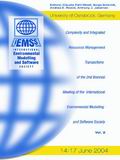Applying agent technology in environmental management systems under real-time constraints
Abstract
Changes in the natural environment affect our quality of life. Thus, government, industry, and the public call for integrated environmental management systems capable of suppling all parties with validated, accurate and timely information. The `near real-time’ constraint reveals two critical problems in delivering such tasks: the low quality or absence of data, and the changing conditions over a long period. These problems are common in environmental monitoring networks and although harmless for off-line studies, they may be serious for near real-time systems. In this work, we discuss the problem space of near real-time reporting Environmental Management Systems and present a methodology for applying agent technology this area. The proposed methodology applies powerful tools from the Artificial Intelligence sector, such as software agents and machine learning, and identifies the potential use for solving real-world problems. An experimental agent-based prototype developed for monitoring and assessing air-quality in near real time is presented. A community of software agents is assigned to monitor and validate measurements coming from several sensors, to assess air-quality, and, finally, to fire alarms to appropriate recipients, when needed. The architecture of the developed system, its domain ontology, and typical agent interactions are presented. Finally, the deployment of a real-world test case is demonstrated.
Download full text in pdf format
 Published as:
Published as:
I. N. Athanasiadis,
P. A. Mitkas,
Applying agent technology in environmental management systems under real-time constraints,
2nd Intl Congress on Environmental Modelling and Software (iEMSs 2004), vol. 2, pg. 531-536,
2004, International Environmental Modelling and Software Society (iEMSs).
You might also enjoy (View all publications)
- CY-Bench: A comprehensive benchmark dataset for sub-national crop yield forecasting
- Hybrid phenology modeling for predicting temperature effects on tree dormancy
- To measure or not: A cost-sensitive, selective measuring environment for agricultural management decisions with reinforcement learning
